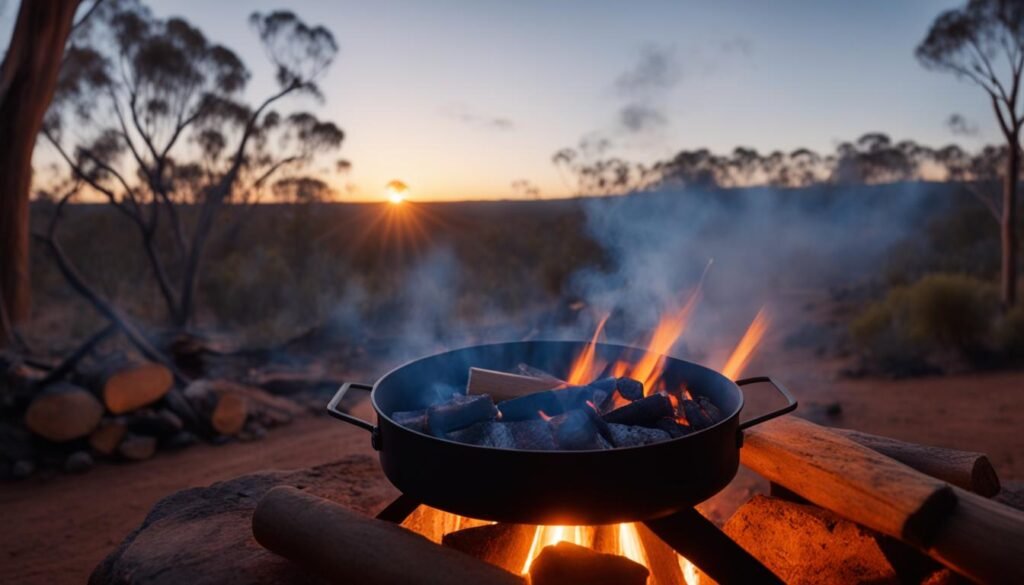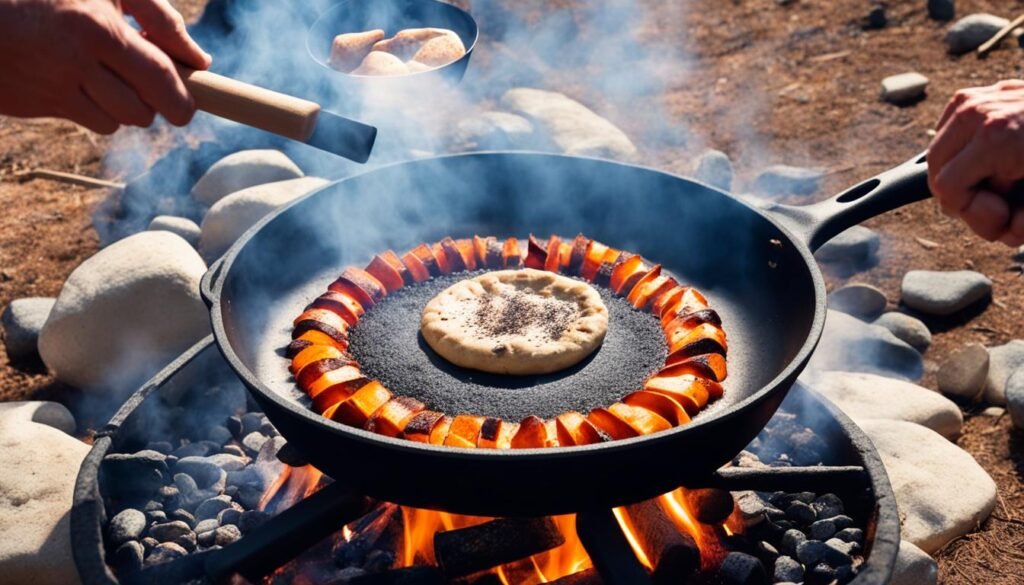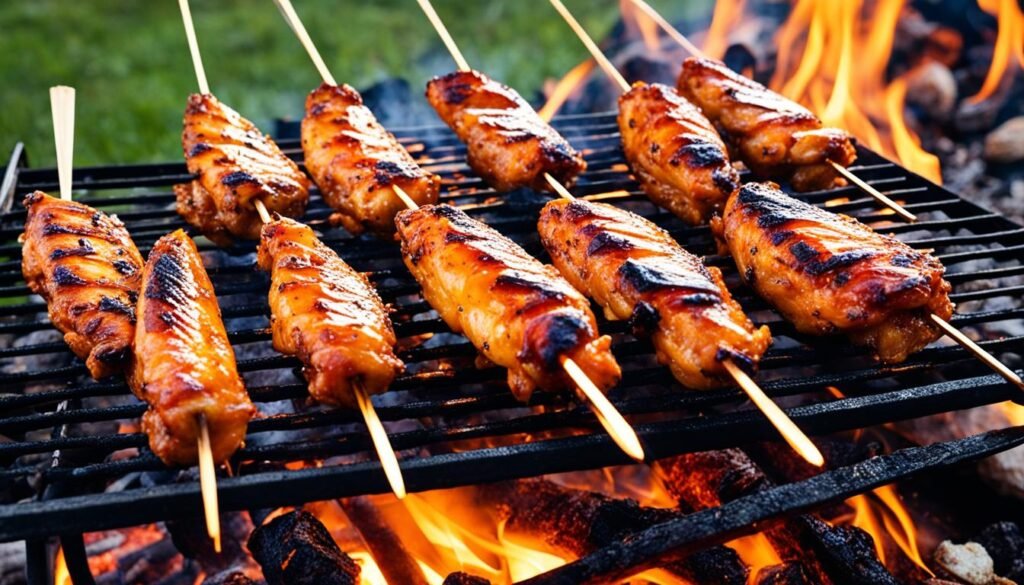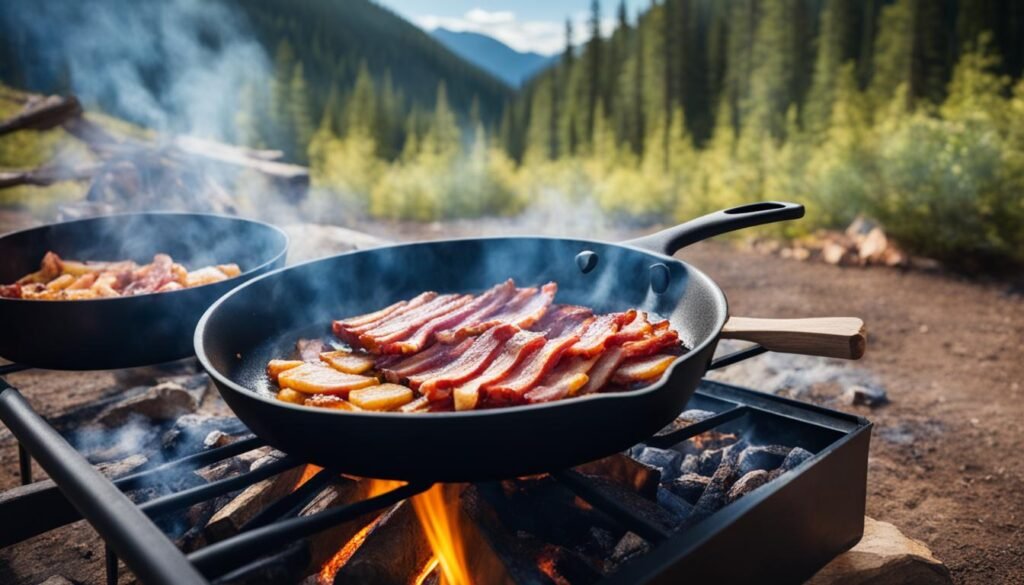When it comes to outdoor cooking, few things evoke the spirit of adventure and tradition quite like cooking damper on a campfire. This iconic Australian bread holds a special place in the hearts and taste buds of many, with its simple yet delicious flavors. Whether you’re a seasoned camper or a first-time outdoor enthusiast, learning how to cook damper on a campfire is a must-try experience.
Key Takeaways:
- How to cook damper on a campfire is a skill worth mastering for any outdoor cooking enthusiast.
- Damper is a traditional Australian bread made with basic ingredients like flour, butter, milk, and water.
- Customize your damper by adding ingredients like cheese, herbs, or dried fruits.
- Enjoy damper warm with butter and your favorite spreads or use it as a versatile bread for sandwiches.
- Cooking damper on a campfire is a beloved tradition that connects people to nature and the rich history of Australian cuisine.
The History of Damper
Damper, a traditional Australian bread, has a fascinating history deeply rooted in campfire cooking. It originated as a simple and portable bread that served the needs of drovers and stockmen who worked in remote locations, relying on limited ingredients. With just flour, salt, and water, they were able to create a hearty and filling bread to sustain themselves during long journeys.
The resourcefulness and ingenuity of early Australian settlers are embodied in this humble bread. The simplicity of the recipe reflects the practicality of those who relied on basic ingredients and cooking methods. Damper became a staple in the diet of laborers, often paired with dried meat or golden syrup.
Throughout the years, damper has retained its significance in Australian culture. It is not only a delicious treat but also a symbol of resilience and connection to the land. The act of baking damper over a campfire evokes a sense of tradition and nostalgia, harking back to the days when settlers relied on their ingenuity to sustain themselves in challenging environments.
“Damper is more than just a bread, it’s a testament to the resourcefulness of our ancestors and the unique cultural heritage of Australia.”
The Ingredients and Method of Making Damper
Making damper is a simple process that requires only a few ingredients and basic steps. The main ingredients for this delicious campfire bread include self-raising flour, salt, cold butter, milk, and water.
To begin, take the self-raising flour and salt and rub them together with cold butter until the mixture resembles breadcrumbs. This step ensures that the damper will be light and fluffy when baked.
Next, create a well in the center of the flour mixture and pour in the milk and water. Using a butter knife, mix the ingredients together until the dough starts to come together. It’s important not to overmix, as this can result in a dense bread.
Once the dough has formed, turn it out onto a lightly floured surface and gently knead it into a ball. Kneading helps to develop the gluten in the flour, giving the damper a good texture.
Now, place the dough on a greased oven tray and flatten it into a round shape. To prevent the damper from splitting while baking, make a cross-shaped cut on the top of the dough.
Brush the top of the damper with a little milk to enhance its golden color and crispness. Then, it’s time to bake the damper in the oven. Preheat the oven to 180°C (350°F) and bake the damper for approximately 30 minutes or until it turns golden brown and is cooked through.
Once baked, remove the damper from the oven and let it cool slightly. Best served warm, the freshly baked damper can be enjoyed with various toppings or fillings. From butter and jam to savory spreads or even used as a base for sandwiches, your damper creations are only limited by your imagination.
Tips and Variations for Making Damper
Enhance your damper-making experience with these helpful tips and creative variations. Whether you’re a seasoned campfire cook or a beginner, these ideas will take your damper to the next level.
Tip 1: No Self-Raising Flour? No Problem!
If you don’t have self-raising flour on hand, you can create a suitable substitute using plain flour and a tablespoon of baking powder or bicarbonate of soda. Simply mix the two ingredients together before incorporating them into your damper recipe. This will ensure that your bread rises perfectly, even without self-raising flour.
Tip 2: Get Creative with Additions
One of the joys of making damper is the ability to customize the dough with your favorite ingredients. Consider adding cheese and chives for a savory twist, or mix in fresh herbs to infuse the bread with delightful flavors. For a heartier option, try incorporating crispy bacon bits. Alternatively, adding dried fruits like sultanas or blueberries can provide a hint of sweetness. Let your imagination run wild and experiment with different flavors to create a truly unique damper.
Tip 3: Explore Flavors with Spices
If you’re craving a sweeter damper, you can add a touch of spice to infuse the bread with warmth and complexity. Try incorporating spices like cinnamon or nutmeg into the dough for a delightful aroma and taste. For a tropical twist, consider mixing in some shredded coconut. These added spices and flavors can transform a traditional damper into a delightful treat that will impress your campfire companions.
Tip 4: On-The-Go Fillings
Damper is not just a bread; it can also serve as the perfect vessel for a variety of fillings. When enjoying it as a sandwich, traditional fillings like ham, cheese, and lettuce work wonderfully. However, feel free to explore other options and get creative with your ingredient combinations. The simplicity of damper allows the flavors of the fillings to shine, making every bite a delicious experience.
Tip 5: Cooking Techniques
When it comes to cooking your damper, there are different techniques you can try. Baking it in the oven is the most common method, but if you’re camping and want an authentic campfire experience, you can also cook it in a camp oven or wrap the dough in foil and bake it directly in the fire. Experimenting with different cooking techniques can add an extra layer of adventure and excitement to your damper-making process.
Remember, damper is a versatile bread that allows for endless variations and personal touches. Don’t be afraid to experiment and let your creativity shine through. Your unique damper creations will not only satisfy your hunger but also impress your fellow campers or family members.
| Tips for Making Damper | Variations |
|---|---|
| No self-raising flour? Use plain flour with a tablespoon of baking powder or bicarbonate of soda as a substitute. | Cheese and chives |
| Add your favorite fillings to the dough, such as herbs, bacon, or dried fruits like sultanas or blueberries. | Herbs |
| Experiment with spices like cinnamon or coconut for a sweeter bread. | Dried fruits |
| Get creative with different cooking techniques, such as baking in a camp oven or directly in the fire. | Cinnamon |
The Tradition of Campfire Cooking
Cooking on a campfire is a beloved tradition in many cultures around the world. It connects people to nature and allows them to enjoy the beauty of the outdoors while creating delicious meals. Campfire cooking often involves simple recipes using basic ingredients, relying on the heat and flames of the fire to cook the food. It evokes a sense of nostalgia and adventure, making it a memorable experience for everyone involved. Damper is one such campfire recipe that has stood the test of time and continues to be enjoyed by families and campers worldwide.
Using traditional campfire cooking techniques to prepare a tasty meal.
When cooking on a campfire, the experience goes beyond just preparing food. It’s about embracing the wilderness and immersing oneself in the natural surroundings. There’s a unique charm in gathering around the fire, feeling its warmth, and witnessing the dancing flames as meals come to life.
Campfire cooking traditions have been passed down through generations, preserving not only recipes but also stories and memories. Whether it’s roasting marshmallows for s’mores, grilling meats and vegetables on a skewer, or baking delicious campfire pies, the act of cooking in the great outdoors adds a special touch to the culinary experience.
Outdoor Cooking Techniques and Tools
When it comes to campfire cooking, there are various techniques and tools that can be utilized to prepare a wide array of dishes. Here are a few popular methods:
- Grilling: Use a portable grill or a makeshift grill grate placed over the fire to cook meats, vegetables, and even fruits.
- Dutch Oven Cooking: A cast iron Dutch oven is a versatile tool that allows you to bake, roast, stew, and fry delicious meals over the campfire.
- Skewering: Skewers or sticks can be used to grill kebabs, sausages, and even bread or marshmallows.
- Campfire Pots and Pans: Bring along lightweight camping pots and pans for easy cooking and cleaning.
These techniques, combined with the natural flavors and smoky aromas imparted by the campfire, create a unique and satisfying meal experience.
The Joys of Wilderness Cooking
There’s something truly special about cooking and eating in the wilderness. The simplicity and primal nature of campfire cooking take us back to our roots, reminding us of our connection to nature and the earth. It’s a chance to escape the confines of modern life, slow down, and relish in the moment.
Outdoor cooking allows us to fully appreciate the ingredients, flavors, and techniques that have been used for centuries. It’s a celebration of tradition and a reminder of the beauty and simplicity of nature.
Whether it’s a hearty stew simmering over an open fire, a freshly baked loaf of bread, or a simple cup of coffee brewed with foraged wild herbs, wilderness cooking awakens our senses and nourishes our souls.
Preserving Outdoor Cooking Traditions
As we continue to embrace modern advancements in technology and convenience, it’s crucial to preserve and promote outdoor cooking traditions. By passing down recipes, techniques, and knowledge to future generations, we ensure that the joys of campfire cooking endure.
Through shared experiences and storytelling, campfire cooking traditions become part of our cultural heritage, connecting us to our ancestors and the land we call home. It’s a celebration of simplicity, resourcefulness, and the unbreakable bond between humans and nature.
| Campfire Cooking Tips | Benefits of Outdoor Cooking |
|---|---|
| 1. Always bring sturdy cookware suitable for campfire use. | 1. Connects us with nature and the environment. |
| 2. Use dry firewood to ensure a steady and consistent flame. | 2. Encourages mindfulness and a sense of presence. |
| 3. Prepare ingredients beforehand to make the cooking process smoother. | 3. Creates a sense of community and shared experiences. |
| 4. Experiment with different spices, herbs, and marinades for added flavor. | 4. Allows for a deeper appreciation of food and its origins. |
| 5. Practice fire safety and extinguish the fire completely after cooking. | 5. Provides an opportunity for learning and passing down traditions. |
Serving and Enjoying Damper
Once the damper is baked to perfection, it’s time to savor its warm and comforting flavors. There are several delightful ways to serve and enjoy this versatile campfire bread.
1. Simple and Classic:
The simplest way to enjoy damper is to savor it on its own, still warm from the oven. Cut a thick slice and spread it with butter and your favorite jam or golden syrup. This timeless combination brings out the rich and buttery taste of the bread.
2. Savory Sandwiches:
Damper can also be used as a delicious bread for campfire sandwiches. Pile it high with your choice of fillings—smoked ham, roasted turkey, or even grilled vegetables. Add a layer of tangy cheese, some crunchy lettuce, and a dollop of mustard or mayo for a satisfying meal on the go.
3. Gourmet Fillings:
Elevate your damper experience by experimenting with gourmet fillings. Think creamy brie with caramelized onions, thinly sliced prosciutto with arugula and balsamic glaze, or roasted chicken with roasted red peppers and pesto. The soft and slightly chewy texture of damper beautifully complements the flavors of these gourmet combinations.
4. Campfire Chili Companion:
Pair your damper with a hearty campfire chili for a satisfying and complete meal. The crusty exterior and soft center of the bread are perfect for soaking up the savory flavors of the chili. This combination is a comforting treat that will warm you up on cool outdoor evenings.
5. Sweet Treat:
Don’t limit yourself to savory options; damper can also be transformed into a delightful dessert. Serve warm slices of damper with your favorite sweet spreads like Nutella or melted chocolate. For an indulgent twist, top it with a scoop of vanilla ice cream and drizzle it with warm caramel sauce.
No matter how you choose to enjoy it, damper adds a touch of rustic charm to any campfire meal. Its simplicity and versatility make it a favorite among outdoor cooking enthusiasts and a delightful addition to any menu.

| Meal Idea | Description |
|---|---|
| Breakfast Sandwich | Damper filled with scrambled eggs, crispy bacon, and melted cheese. |
| Cheese and Herb Damper | A savory twist on damper with added grated cheese and mixed herbs. |
| Fruit-Filled Damper | Sweeten your damper by adding dried fruits like sultanas or blueberries to the dough. |
| Campfire Pizza | Use damper as a base for a delicious campfire pizza, topped with tomato sauce, cheese, and your favorite toppings. |
| Damper Bread Pudding | Transform leftover damper into a tasty bread pudding by soaking it in a mixture of milk, eggs, sugar, and spices before baking. |
Freezing and Storing Damper
Properly freezing and storing damper ensures that you can enjoy this delicious campfire bread at a later time. Here’s how you can preserve the freshness and flavor of your damper:
- Cool Completely: Before freezing damper, allow it to cool completely at room temperature. This prevents the formation of condensation within the packaging.
- Wrap in Aluminum Foil: Wrap the cooled damper tightly in aluminum foil. This helps to retain moisture and prevent freezer burn.
- Freeze: Place the wrapped damper in the freezer and ensure it is stored upright to maintain its shape. Damper can be kept frozen for up to 3 months.
- Thawing and Reheating: When you’re ready to enjoy your frozen damper, there are two methods to consider. Thaw it at room temperature for a few hours until it softens, or reheat it in the oven for 5-10 minutes at a moderate temperature (350°F/175°C) until warmed through.
- Enjoying Leftovers: While damper is best enjoyed fresh, it can become hard within a day or two. If you have leftover damper, you can lightly toast it the following day to revive its texture and flavor.
| Freezing Damper | Storing Damper | Thawing and Reheating Damper |
|---|---|---|
Note: Damper is best enjoyed fresh, but freezing and reheating methods can help extend its shelf life for later enjoyment.
The Significance of Damper in Australian Culture
Damper holds a significant place in Australian culture. It represents the resourcefulness and resilience of early settlers who relied on simple ingredients and cooking methods to sustain themselves in remote areas. The cultural significance of damper lies in its connection to the land and the traditions passed down through generations.
Australian food traditions are deeply rooted in the country’s history and diverse cultural influences. The simple yet delicious damper recipe is a reflection of the traditional Australian way of life, where people made the most of what they had and created nourishing meals with limited resources.
Campfire recipes in Australia are an integral part of the nation’s culinary heritage. Cooking damper over a campfire is not only a way to prepare food but also a communal activity that brings people together. Australian families often gather around the campfire, sharing stories and enjoying freshly baked damper, creating lasting memories and strengthening family bonds.
“Damper is more than just a bread—it’s a symbol of our history and identity. It represents the pioneering spirit and the ability to adapt and thrive in even the harshest of environments. It’s a taste of tradition that connects us to our roots.”
– Sarah Thompson, Australian food historian
Moreover, damper remains an iconic dish in Australian cuisine, showcasing the unique flavors and traditions of the country. It is deeply ingrained in the Australian culinary landscape and is celebrated as a cultural symbol.
Australian Food Traditions
Australian food traditions encompass a wide range of ingredients and cooking techniques influenced by indigenous communities, European settlers, and subsequent waves of immigration. The rich and diverse culinary heritage is celebrated throughout the country, with dishes like damper representing the simplicity, resourcefulness, and adaptability that characterizes Australian cuisine.
The Role of Damper in Campfire Cooking
Campfire cooking has been a longstanding tradition in Australia, and damper is a staple campfire recipe. The simplicity of the damper recipe makes it ideal for cooking over an open fire, where the dough can be baked in a camp oven or wrapped in foil and cooked in the coals. The smoky flavor and rustic charm of campfire-cooked damper add to its appeal and make it a beloved part of the camping experience.
| The Cultural Significance of Damper | Australian Food Traditions | Campfire Cooking in Australia |
|---|---|---|
| – Represents resourcefulness and resilience | – Reflects the diverse cultural influences | – A longstanding tradition |
| – Connects to Australian history and identity | – Celebrates the simplicity and adaptability of Australian cuisine | – Enhances the camping experience |
| – Strengthens family bonds and creates lasting memories | – Showcases the unique flavors and traditions of the country | – Brings people together around the campfire |
Damper’s cultural significance, combined with its delicious taste and connection to the Australian way of life, ensures its continued popularity and its place as an iconic dish in Australian culture.

Conclusion
Cooking damper on a campfire is a culinary experience that goes beyond the act of preparing a delicious bread. It embodies the spirit of Australian culture and the sense of adventure that comes with outdoor cooking. The simplicity of the damper recipe and the connection to nature make it a cherished tradition for many Australians and outdoor enthusiasts.
Whether you’re camping in the wilderness, hiking through rugged terrains, or simply enjoying a bonfire in your backyard, the process of making damper on a campfire allows you to embrace the rich heritage of Australian bushcraft. It’s a time to gather around the fire, mix the basic ingredients, and savor the aroma and flavors of this iconic Aussie classic.
As you patiently wait for the damper to rise and bake over the open flames, you’ll not only enjoy a tasty treat but also create lasting memories with family and friends. The crackling fire, the smell of the campfire, and the satisfaction of sharing a meal cooked in the wild are all part of the campfire experience.
In conclusion, cooking damper on a campfire is a delightful way to connect with nature, appreciate the resourcefulness of early settlers, and indulge in the unique flavors of Australian cuisine. So why not gather around the fire, immerse yourself in the outdoor adventure, and enjoy the simple pleasures of damper cooking on a campfire?
FAQ
What is damper?
Damper is an iconic Australian wheat-based bread traditionally baked at a campfire in a camp oven. It is a simple recipe made with self-raising flour, salt, cold butter, milk, and water.
How is damper traditionally enjoyed?
Damper is traditionally served warm with butter and jam or golden syrup. It can also be used as a bread for sandwiches and enjoyed with a cup of Billy tea.
What are some variations of damper?
Damper can be customized by adding ingredients like cheese and chives, herbs, or dried fruits to the dough. It can also be flavored with spices like cinnamon or coconut.
How do I make damper on a campfire?
To make damper on a campfire, you will need self-raising flour, salt, cold butter, milk, and water. The butter is rubbed into the flour and salt, then the milk and water are added. The dough is mixed, kneaded, shaped, and baked over the campfire until golden brown and cooked through.
Can I freeze damper?
Yes, damper can be frozen for up to 3 months. Thaw it at room temperature or reheat it in the oven before enjoying.
What is the significance of damper in Australian culture?
Damper represents the resourcefulness and resilience of early Australian settlers. It is a beloved classic that is enjoyed as a symbol of tradition and nostalgia.
How does campfire cooking connect people to nature?
Campfire cooking allows people to enjoy the beauty of the outdoors while creating delicious meals. It evokes a sense of adventure and creates lasting memories.







